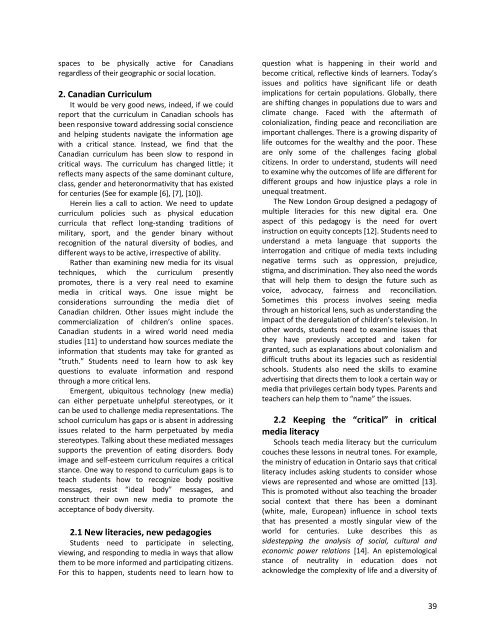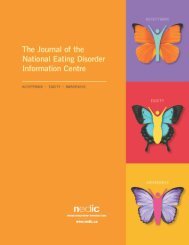NEDIC Conference Journal 2018
You also want an ePaper? Increase the reach of your titles
YUMPU automatically turns print PDFs into web optimized ePapers that Google loves.
spaces to be physically active for Canadians<br />
regardless of their geographic or social location.<br />
2. Canadian Curriculum<br />
It would be very good news, indeed, if we could<br />
report that the curriculum in Canadian schools has<br />
been responsive toward addressing social conscience<br />
and helping students navigate the information age<br />
with a critical stance. Instead, we find that the<br />
Canadian curriculum has been slow to respond in<br />
critical ways. The curriculum has changed little; it<br />
reflects many aspects of the same dominant culture,<br />
class, gender and heteronormativity that has existed<br />
for centuries (See for example [6], [7], [10]).<br />
Herein lies a call to action. We need to update<br />
curriculum policies such as physical education<br />
curricula that reflect long-standing traditions of<br />
military, sport, and the gender binary without<br />
recognition of the natural diversity of bodies, and<br />
different ways to be active, irrespective of ability.<br />
Rather than examining new media for its visual<br />
techniques, which the curriculum presently<br />
promotes, there is a very real need to examine<br />
media in critical ways. One issue might be<br />
considerations surrounding the media diet of<br />
Canadian children. Other issues might include the<br />
commercialization of children’s online spaces.<br />
Canadian students in a wired world need media<br />
studies [11] to understand how sources mediate the<br />
information that students may take for granted as<br />
“truth.” Students need to learn how to ask key<br />
questions to evaluate information and respond<br />
through a more critical lens.<br />
Emergent, ubiquitous technology (new media)<br />
can either perpetuate unhelpful stereotypes, or it<br />
can be used to challenge media representations. The<br />
school curriculum has gaps or is absent in addressing<br />
issues related to the harm perpetuated by media<br />
stereotypes. Talking about these mediated messages<br />
supports the prevention of eating disorders. Body<br />
image and self-esteem curriculum requires a critical<br />
stance. One way to respond to curriculum gaps is to<br />
teach students how to recognize body positive<br />
messages, resist “ideal body” messages, and<br />
construct their own new media to promote the<br />
acceptance of body diversity.<br />
2.1 New literacies, new pedagogies<br />
Students need to participate in selecting,<br />
viewing, and responding to media in ways that allow<br />
them to be more informed and participating citizens.<br />
For this to happen, students need to learn how to<br />
question what is happening in their world and<br />
become critical, reflective kinds of learners. Today’s<br />
issues and politics have significant life or death<br />
implications for certain populations. Globally, there<br />
are shifting changes in populations due to wars and<br />
climate change. Faced with the aftermath of<br />
colonialization, finding peace and reconciliation are<br />
important challenges. There is a growing disparity of<br />
life outcomes for the wealthy and the poor. These<br />
are only some of the challenges facing global<br />
citizens. In order to understand, students will need<br />
to examine why the outcomes of life are different for<br />
different groups and how injustice plays a role in<br />
unequal treatment.<br />
The New London Group designed a pedagogy of<br />
multiple literacies for this new digital era. One<br />
aspect of this pedagogy is the need for overt<br />
instruction on equity concepts [12]. Students need to<br />
understand a meta language that supports the<br />
interrogation and critique of media texts including<br />
negative terms such as oppression, prejudice,<br />
stigma, and discrimination. They also need the words<br />
that will help them to design the future such as<br />
voice, advocacy, fairness and reconciliation.<br />
Sometimes this process involves seeing media<br />
through an historical lens, such as understanding the<br />
impact of the deregulation of children’s television. In<br />
other words, students need to examine issues that<br />
they have previously accepted and taken for<br />
granted, such as explanations about colonialism and<br />
difficult truths about its legacies such as residential<br />
schools. Students also need the skills to examine<br />
advertising that directs them to look a certain way or<br />
media that privileges certain body types. Parents and<br />
teachers can help them to “name” the issues.<br />
2.2 Keeping the “critical” in critical<br />
media literacy<br />
Schools teach media literacy but the curriculum<br />
couches these lessons in neutral tones. For example,<br />
the ministry of education in Ontario says that critical<br />
literacy includes asking students to consider whose<br />
views are represented and whose are omitted [13].<br />
This is promoted without also teaching the broader<br />
social context that there has been a dominant<br />
(white, male, European) influence in school texts<br />
that has presented a mostly singular view of the<br />
world for centuries. Luke describes this as<br />
sidestepping the analysis of social, cultural and<br />
economic power relations [14]. An epistemological<br />
stance of neutrality in education does not<br />
acknowledge the complexity of life and a diversity of<br />
39




